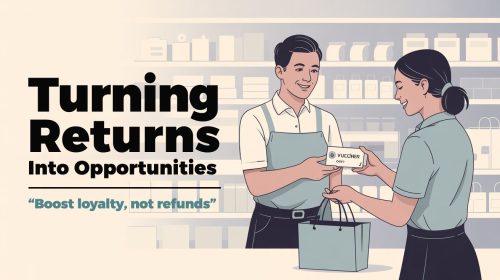Returns might seem harmless, but each one can quietly cost your business $10–$20 — or more. Discover the hidden costs of returns and how to reduce them with smarter processes.
Returns might seem harmless, but each one can quietly cost your business $10–$20 — or more. Discover the hidden costs of returns and how to reduce them with smarter processes.

When a customer clicks “Return Item,” it feels simple — even expected. But behind that tiny action hides a big truth: returns are expensive, especially for small businesses.
Unlike enterprise retailers who treat returns as a cost of doing business, SMBs (small and medium-sized businesses) often suffer in silence. One returned product can eat up your margins, drain your time, and sometimes, lose a customer forever.
So, let’s get brutally honest about returns:
What’s the real cost? Why should you care? And what can you do to fix it — without hurting your customer experience?
You might think:
“It’s just a refund. I’ll get the product back and move on.”
But here’s the reality: returns come with a chain reaction of hidden expenses.
Let’s say you sell a product for $100. If it’s returned, here’s a breakdown of what that might actually cost:
| Cost Category | Estimated Amount (USD) |
|---|---|
| Return Shipping (paid by merchant) | $5 – $10 |
| Inspection & Restocking Labor | $3 – $6 |
| Repackaging Materials | $1 – $2 |
| Product Depreciation (used/opened item) | $20 – $50 |
| Marketing/Customer Acquisition Loss | $5 – $15 |
| Total Estimated Return Cost | $10 – $20+ |
According to Optoro, returns cost U.S. retailers more than $760 billion annually, and up to 66% of returned items lose resale value.
For small stores, even 10 returns per month could mean $200–$500 gone, not even counting lost time or opportunity cost.
Here’s a real example.
Lily owns a boutique clothing brand on Shopify. She thought her generous return policy would build loyalty. But after digging into her numbers with Backsy, she realized she lost nearly $1,600 in just one month due to:
“I thought I was offering a great experience,” she said, “but really, I was losing money — quietly.”
Returns don’t just refund revenue. They burn through your backend.
Let’s play this out:
Net result: You earn nothing. You might even lose money.
Multiply that by 30 returns?
That’s your rent, salary, or next ad campaign gone.

Some returns are inevitable. But refunds shouldn’t always be the only option.
Exchanges keep revenue in your business, and they give you a second chance to deliver satisfaction.
According to Narvar, nearly 57% of online shoppers say they’re open to making an exchange if the process is simple and fast.
That’s where Backsy comes in.
Backsy is built for Shopify stores — especially those without huge ops teams.
Here’s how it turns return pain into profit potential:
Only allow returns for certain products, customers, or conditions. You’re in control.
Show customers better-matching items. Offer a discount for swapping.
(“Not happy with the size? Try another color!”)
No more back-and-forth emails. Let customers self-serve. Save time, save sanity.
Know why returns happen — size issues, wrong expectations, quality.
Then fix it. Improve product listings. Reduce future returns.
Offer a clean, branded portal that feels like part of your store.
Trust builds loyalty. Loyalty builds LTV.
Think about it.
You’re selling a $100 item. A return can cost you $20+.
That’s 20% gone — instantly.
Worse? If the item loses resale value, you’re now stuck with inventory you can’t move, or have to sell at a heavy loss.
Every “free return” you offer has a hidden price tag.
Don’t ignore it.
Most small merchants never track:
Backsy gives you all of this — in real time.
Data is your edge in a competitive market. If you don’t measure, you can’t improve.
Even without fancy tools (yet), here are some small changes that reduce return risk:
And if you’re ready to automate the process — Backsy is your next move.
Returns are part of running an eCommerce business — but they don’t have to wreck your margins.
For small businesses, one refund isn’t just lost revenue. It’s lost time, energy, trust, and future growth.
But with the right tools and strategies, you can turn returns into revenue-saving moments.
Let Backsy help you create a return experience that’s simple for customers — and profitable for you.
🔁 Start your free trial today at Backsy.io
Industry studies estimate $10–$20 per return, including shipping, labor, depreciation, and overhead. It’s even higher for luxury or bulky items.
Yes — they retain revenue and keep the customer engaged. With Backsy, you can offer smarter exchanges that actually solve the problem.
Absolutely. Backsy is designed for small and medium Shopify merchants and scales with your business. It pays for itself in reduced loss.






Table of Contents
ToggleDeliver a seamless return & exchange experience that builds trust and drives revenue.
From automating return flows to offering flexible refund options, Backsy helps modern Shopify brands reduce friction, save hours, and keep customers coming back
Streamline returns & exchanges with powerful automation, flexible conditions, and a seamless customer experience — built for Shopify brands.
Product
Get the latest updates and tips from Backsy.
© 2025 created with Backsy